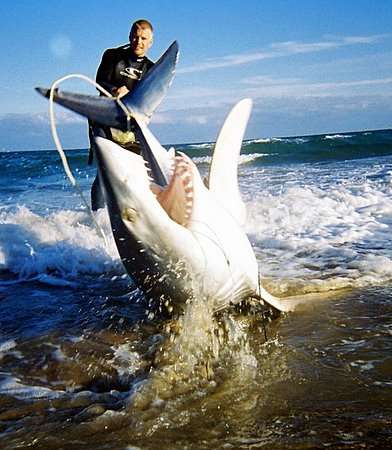
Mako Shark

Mako Shark

Common Names: Shortfin Mako Shark, Mako Shark.
Latin Name: Isurus oxyrinchus
Family: Lamnidae
Identification: Long conical snout. Large blue/black eyes. Lower jaw contains multiple rows of inwardly curving teeth. Pectoral fin length shorter than length of head. Juveniles often have more rounded dorsal and pectoral fins. Well developed caudal keel. Crescent shaped tail. Back coloration bright blue to purple/slate grey. Underside off white. In the Shortfin Mako Shark population of the Azores and Cape Verde Islands the underside of the snout and jaw of large adults are dusky which is similar to the Longfin Mako's coloration but characteristic analysis confirms that they are definitely Isurus oxyrinchus.
Size: Maximum recorded size 4.45m but more commonly 2m. Size at birth 60-70cm
Habitat: Coastal and oceanic in depths of up to 500m. Prefers clear water over turbid. Often seen swimming just below the surface with first dorsal fin visible.
Abundance and distribution: Circumtropical and temperate in waters usually warmer than 16 degrees. Highly migratory with migrations recorded up to 2500mi.
Diet and Behavior: Cruises open water in search of prey species. Main diet consists of bony fishes and squid. Wounds and scars on the ventral surface and caudal peduncle of swordfish and tuna indicate that Shortfin Mako Sharks often attack from below. As well as a large assortment of bony fishes, Makos also consume a variety of sharks and rays (especially in South Africa) and larger specimens may attack dolphins and small cetaceans.
Reproduction: Ovoviviparous. Recorded litter size 2 - 10 but may be higher. Gestation has been estimated at 14 months.
Observations:
Photographs: San Diego, California.
Similar species:
Diving logistics: Chris Fallows runs an ecotourism operation in South Africa in which Mako and Blue Sharks are commonly seen.
Until recently there were Blue/Mako Shark operators working out of Southern California but due to over-fishing fewer and fewer sharks attended the feeds until shark watching trips were no longer viable.

check out Makoman they make custom shark themed chairs and tables using fiberglass Mako heads
ReplyDeletewww.sharkfurniture.com